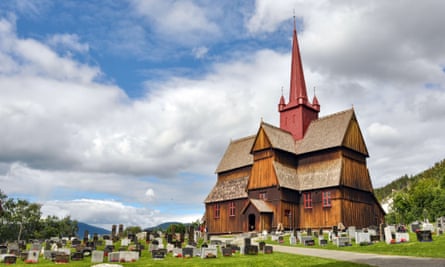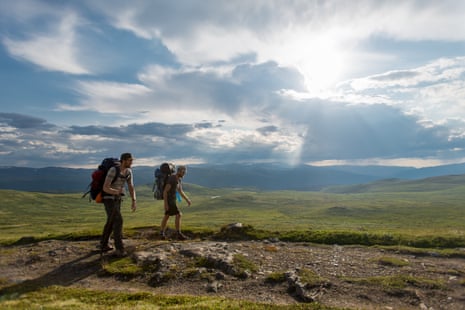We were deep in the Gudbrands valley, several hundred kilometres along St Olav’s Way in Norway, when Stig Grytting got the call. Sitting outside his 13th-century farmhouse, drinking wine and eating homemade bread, he was talking about renovations to the building when the call came. Not the voice of God, you understand, but the buzz of his mobile phone.
“Sorry,” he said apologetically, “this is a pilgrim – I have to answer it.”
I was on day two of a whirlwind taster of one of Europe’s newer pilgrim trails. Though perhaps newer is a bit of a misnomer, because this pathway was first mentioned in the 11th century, in a German-penned “guidebook” written by medieval chronicler Adam von Bremen. In it he described the journey that King Olav II Haraldsson had made back to the country in 1030 after being chased out following his attempt to unite Norway under one crown (his) and one religion (Christianity).

King Olav died in the battle, but miracles were said to have taken place afterwards and he was later canonised. A blind man got his sight back after touching his eyes with Olav’s blood (though why he did this in the first place is a question worth considering), and it is said that when they opened Olav’s grave months after his death, to take him to his final resting place in Trondheim, his body smelt of roses. After that, the pilgrims started coming.
One thing that certainly doesn’t smell sweet is a pilgrim who has spent time on this fabled 643km hike from the capital, Oslo, to the coastal municipality of Trondheim. I should know, a handful of them were sitting in Stig’s home after several days (or even weeks) walking the trail.

“We wanted something quieter than the Camino, but that still had a sense of a journey with a focal end point,” said pilgrims Cynthia and Markus from Germany who had opted to walk half the route over two weeks. I was soon to discover that of the 400 people who walk St Olav’s Way each year, more than 33% are Germans – more than any other nationality, including Norwegians.
Per Gunnar Hagelien, who I met at the pilgrim centre down the road from my hostel the following morning, was part of the team that helped re-establish the route in 1997, 550 years after pilgrimages in Norway – much like in the UK – were banned in 1537, during the reformation.

Pilgrims are well catered for in the valley between Stig’s hostel (Sygard Grytting) – which also offers luxury pilgrim rooms with double beds and private bathrooms – and the Dovre mountains. On this stretch I walked on well-maintained paths which had plenty of signage. Highlights include the 13th-century wooden stave church of Ringebu, which has pilgrim “graffiti” from the 16th century scratched into its walls – a cluster of runic symbols that translate as “From here I was and from here I left.”
Workers at the Pilgrim Centre admitted that re-establishing what they hope will be a rival to Spain’s popular Camino has not been easy. There are few practising Catholics in Norway, so many pilgrims on St Olav’s Way find churches closed and accommodation difficult if they don’t want to carry a tent.

However, over the past couple of years they have been working with locals like Stig to show them that they can make a good business from the increase in human traffic to this rarely visited rural area.
The following day we hiked in pine woods without seeing another soul, strolled through farmland on what felt like secret passageways hidden from those rushing by car, and were treated to a boat ride – rowed by John Wanvik to our final night’s accommodation at Sundet Farm (dorm beds from £35, meals extra), which has been in his family since the 12th century, and is just 16km from Trondheim.
Closer to the start of St Olav’s Way, between Lillehammer and Oslo, I had visited the ruins of Hamar Cathedral encased in glass. Actors were playing the part of Augustine monks, bowing fiddles and singing haunting songs amid the stone walls. Now, I neared the finale – Nidaros Cathedral – and I was coming across more pilgrims. Each had a story to tell, a reason to walk through their problems – from the young man who had served in the military and wanted space to process what he had seen, to the newly retired German couple who had wanted a routine for the eight weeks it took them to walk it.

As I reached Trondheim the next morning, and caught sight of the spires of the holy place where the pilgrims end their journey, I recalled something Frede Fjågesundto, a priest I’d met on the route, had said when I’d asked him about the growing popularity of the pilgrimage.
“I don’t think people are less religious nowadays, but the way they are expressing their belief is different,” he said. “Maybe it’s because we sit in our offices and work with computers throughout the year – not using our bodies – that makes a walking pilgrimage more of a need than it was, even in the earlier days.”
It seems that for many the pathway – rather than the phone – is now calling, allowing us to discover not just a country but, also, ourselves.
Flights were provided by SAS, which flies from several UK airports to Oslo and Trondheim from £80 return. Accommodation was provided by Staur Farm (rooms from £64 B&B, other meals available); Sygard Grytting Farm (bed-only from £27, meals available) and Sundet Farm (bed-only from £36, meals available). Short versions of the St Olav’s Way are possible using trains. More at pilegrimsleden.no
Looking for walking holiday inspiration? Browse The Guardian’s selection of walking holidays on the Guardian Holidays website

Comments (…)
Sign in or create your Guardian account to join the discussion